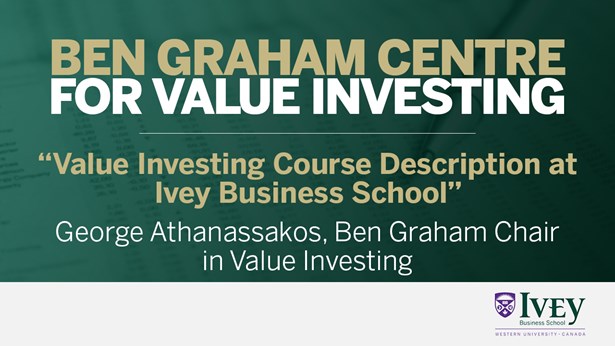Value Investing and Related Courses Taught at Ivey
Click image to view video of Dr. George Athanassakos, Professor of Finance and the Ben Graham Chair in Value Investing, describe the value investing courses taught at Ivey Business School, Western University:
The goal of the course is to deepen students’ understanding of how financial decisions are made in a vast array of settings, incorporating insights from individual and social psychology in modern financial theory. In practice, students will learn the most common “rules of thumb” used in financial decision-making and the potential biases and mistakes that can arise. We'll also consider how behavioral principles can help develop new financial services and products for consumers (and eventually turn a profit).
The primary objective of Corporate Financial Reporting is to prepare general managers to be better users of financial reporting. This involves: being familiar with the structure and content of annual reports; understanding the environment in which financial reporting choices are made; knowing the options available under the current reporting model, and understanding how to use accounting data to make informed decisions. Because a number of central financial accounting issues will be examined in detail, this course will also be useful to those students pursuing professional accounting and finance-related designations. The course covers the most significant measurement and disclosure issues that arise in the preparation and use of current public companies’ financial statements, including the following topics: Revenue and Expense Recognition, Proforma Reporting, Earnings per Share, Employee Stock Options, Capital Assets, Corporate Income Taxes, Employee Future Benefits, Intercorporate Investments, Contingencies, and the Detection of Earnings Management.
This course is designed for students who intend to work for multi-business enterprises (as product and general managers or as professional staff) or with multi-business enterprises (as consultants, accountants, investment bankers, analysts, etc.). Multi-business organizations are those enterprises that have, under the active management of a corporate head office, more than one business unit or division. Most of the companies featured in the cases used in this course are examples of this type of entity, although we do have some cases at the extremes to illustrate the full spectrum of corporate level issues. The definition of a multi-business enterprise does not include the pure holding company form - companies that hold passive positions (generally partial ownership) in multiple businesses but are not involved in the active management of those underlying business - they are portfolio investors. As such they are closer to mutual funds and may have investment strategies but they do not have corporate strategies for creating value.
The objective of this course is to introduce students to the foundations of managerial economics. Special emphasis is placed on the microeconomics of competitive strategy and public policy. The course is designed to support Ivey’s mission “we develop leaders who think globally, act strategically, and address critical issues facing organizations and society, through impactful research and transformative learning experiences.” Emphasis in this course is on real-world business topics. Students will use diagrams, mathematics (simple algebra only) and data analysis throughout the course to develop frameworks and tools that will help them be better decision-makers. Microeconomics for managers aims to improve strategic and systematic thinking within firms’ internal and external environments. Students will learn concepts that enable them to apply microeconomic concepts to actual problems in competitive strategy, regulation and policy.
Value investors address firm-specific risk by applying a ‘margin of safety’. This course explores ways by which the other component of risk - macro risk - may be assessed within a value investing approach to investing and, when appropriate, hedged. In the process, and to determine how much macro risk is present, the course will provide students with various methods for determining an approximate fair value for the overall stock market, compare it to its fair value and illustrate why it is important to take these steps when deciding whether (and how) to hedge. Data exercises throughout the course support the practical orientation of the course.
This course expands on the techniques of valuation presented in the core finance course. The topics will include interest rate determination, discount rate setting, comparable ratio establishment, cash flow estimation and bond and equity valuation models. The principles involved are explored and applied within the context of equity valuation, valuation for mergers and acquisitions, and government and corporate debt pricing. The use of data bases for financial analysis based on group exercises is integrated with lecture learning.
The course is intended to teach students the fundamentals of the value investing approach to investment management as developed by Graham and Dodd and expanded by Warren Buffett. The substantive areas covered will be (1) the fundamental assumptions and approaches to value investing (2) techniques for assessing fundamental value based on traditional and value investing-based valuation (3) the design of strategies for searching efficiently for value investing opportunities (4) the structuring of value-based portfolios to control for risk.
